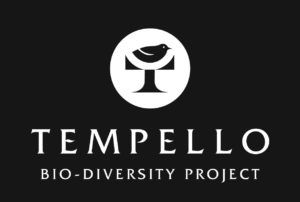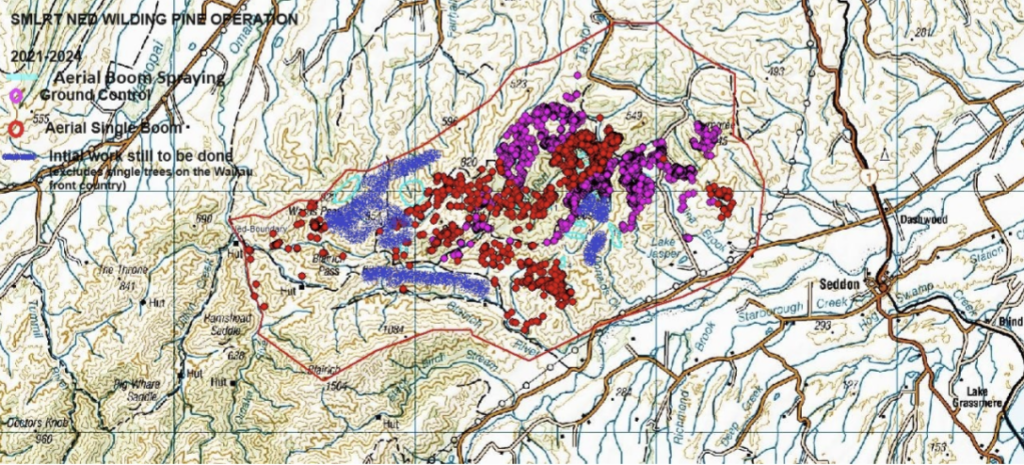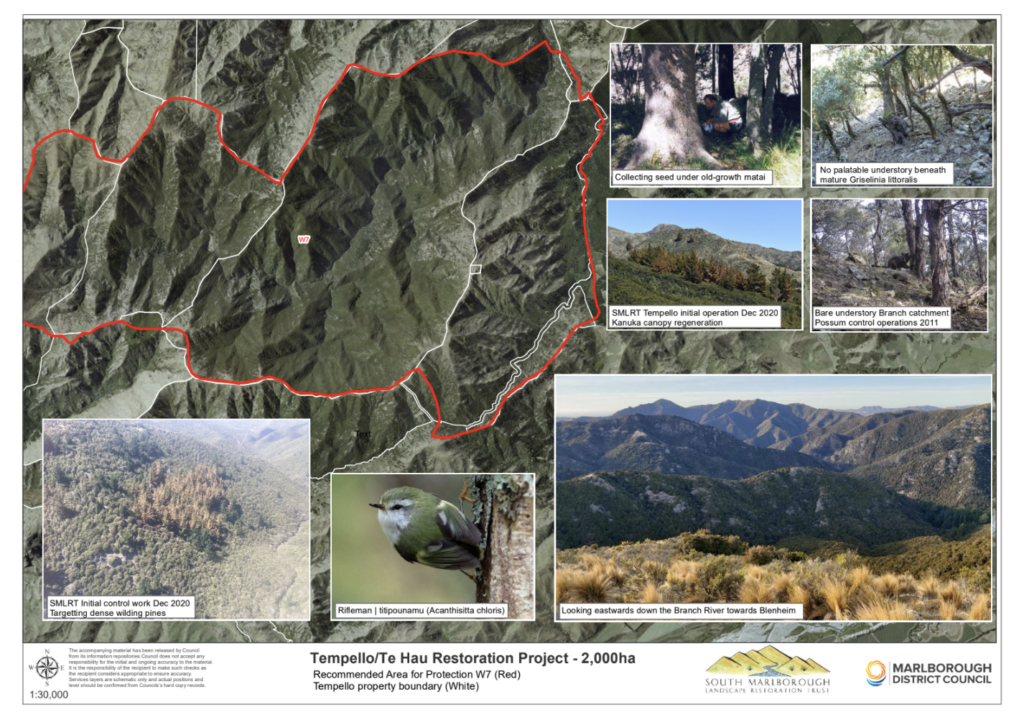1. Introduction:

Tempello is a 5000 hectare private property located a few kilometres to the south of Blenheim, owned by Joanna and David Grigg. The central part of the property includes a 1600 hectare area of forest and rocky bluff systems. In 2009, the “Tempello Farm Park – Conservation and Restoration Management Plan” was prepared (with funding support from the Biodiversity Fund administered by the Department of Conservation and the Ministry for the Environment). Continuing work on this Plan is now known as
The Tempello Bio-Diversity Project.
2. Objectives:
The Griggs vision is to successfully manage a private conservation and
recreational reserve area that represents the essence of Marlborough’s
natural and cultural history within their farm property by:
- protecting and enhancing the diverse native biodiversity values
of the area - preserving and enhancing the social and cultural history of the
area so that it is a special place to visit
3. Summary of Natural and Cultural Values within the Conservation Management Area (CMA).
a) Natural Values.
The Tempello CMA includes a steep forested catchment along with open areas on the higher ridges and rocky spurs ranging in altitude from 300 to 900 metres. Annual rainfall is 600mm. It is located to the south of Blenheim, straddling the ridge between the Wairau and Awatere Valleys. It is located in the Wither Hills Ecological District within the Wairau Ecological Region. The Tempello CMA is the largest natural area within the ecological region, and has the most diverse range of species and plant communities, including the last remnants of original forest species such as red and black beech, matai and Halls totara, as well as extensive areas of fifty year old regenerating kanuka forest and grasslands, shrublands and rocklands. Nine key Vegetation Areas have been identified within the whole natural
area. These areas highlight a variety of special features.
- Long Gully: secondary kohuhu forest, grey scrub and volcanic bluffs
- Pink Broom Ridge: bluffs with uncommon plants, manuka slope, flax gully and orchid saddle
- Tinpot Hut and Pack track gully
- Toi Toi Flat: frost flat shrubland and grassland with wetland riparian zone.
- Black beech remnants with riparian bluff vegetation and lowland forest in kanuka matrix
- Broadleaved gully forest with matai
- The Ned: rocky bluff ridges, shrubland and remnant red beech and Hall’s totara
- Kanuka spur, with gully tree ferns
- Broadleaved riparian forest with cabbage trees and manuka
In regard to Native Fauna, the site is important as it is the largest and most intact natural area in the Ecological Region.
Birds – The area supports populations of rifleman (the only known site in the Wither Hills Ecological District), South island robin (one of two sites in the Ecological District, and tomtit (one of three sites in the Ecological District). Other birds recorded in the site include, brown creeper, fantail, grey warbler, waxeye, bellbird, kingfisher, long tailed cuckoo, black shag, kahu and eastern falcon. Lizards – Five of the 13 species of lizards found in the south Marlborough area are known to be present in the general locality of the Tempello CMA. Of these, three are common (brown gecko species, Marlborough mini
gecko and the common skink), while two are less likely to be found (forest gecko and spotted skink).
Invertebrates – A very limited invertebrate investigation was carried out over two days in December 2008. A wide range of species were found including moths and butterflies, caddis flies, beetles, grasshoppers and crickets and millipedes. Of note was the presence of a native snail species
(Wainuia urnula nasuta) in key vegetation area 3 (Tinpot Hut and pack track gully area), which is generally uncommon.
Freshwater habitat – The Branch River contains a wide range of hydrologic conditions and aquatic habitats including riffles, runs, pool, cascades, small waterfalls, wood debris and cobble beds. Mayflies dominate the aquatic invertebrate fauna and upland bullies are the main fish species found. Koura are common. No migratory fish species such as longfin eel and koaro were observed, or are likely, due to the downstream presence of ephemeral reaches and the Taylor Dam. If fish passage or a trap and transfer system were put in place for the Taylor Dam the habitats present in the Branch River would be suitable for longfin eels and koaro.
b) Cultural/Historic values
In pre-European times Tempello is likely to have been part of a wider landscape used for bird capture by Maori. “The Ned” peak is likely to have been named as a predominant local landmark. Nearby Taylor Pass would have been a main route between the Wairau and Awatere Valleys.
The Tempello property has been farmed since very early in Marlborough’s farming history. It was originally part of Meadowbank Station which in turn was part of some of the founding sheep stations in Marlborough (the Omaka and Wither Runs). The Grigg family purchased Meadowbank Station in 1913 and Tempello was subdivided off in 1951.
The Tempello CMA contains the Tinpot Hut, an adobe clay hut likely built in the 1880’s when timber was scarce as a result of extensive land clearance by burning for farming, and before that by Maori. The Tinpot has been maintained in good condition and has been used as a regular base for mustering ever since it was built although this has been intermittent since 1990 as grazing was reduced in the locality of the hut. It is a popular spot for family gatherings and the Griggs have been generous in allowing public access over the years so that others could visit and explore the area. There is a second derelict adobe hut on the property and a lime kiln, both located in the lower Branch Creek outside the natural area site.
Tracks into the Tinpot area have been upgraded and extended over the years so that today there is a good four wheel drive road right through the natural area, up through the Brancott Gully on the northern side, down into the upper Branch valley near the Tinpot Hut, then up a steep spur to the little Ned before following along the ridge line just below the summit of The Ned and dropping down into the Taylor Valley. Other farm tracks join up with this route, notably a track from the north east along Orchard Spur through neighbouring Meadowbank and a track providing access south into the Blairich River and the Awatere Valley.
Today Tempello is farmed with sustainability and efficiency in mind and the Griggs are continually reviewing and improving their management practices. Tempello was the Marlborough Meat & Wool Monitor Farm from 2002-2005 and the Griggs are also members of the “Sheep 4 Profit” farm monitoring scheme. The focus has been on the management of subterranean annual clover on the property, along with fencing and water reticulation. This has resulted in an improved rate of natural fixation of nitrogen, reduced need for supplementary feeding and reduced incidence of over-grazing of pastures and an overall improvement in farm production and profitability.
The 1600 hectare Conservation Management Area has very little productive value apart from 2-3 months of summer/autumn grazing of merino wethers around the Tinpot Hut and the eastern Branch areas. The Griggs are committed to protecting and enhancing the diverse native biodiversity values and the historic values of the area as well as exploring its commercial potential through recreation and tourism.
4. Conservation Work to Date
Animal and plant pests pose an ongoing threat to the area. Goats, deer and pig hunting is ongoing. Over 7000 goats have been shot in the area. Deer are culled by air and ground. Pig hunting is weekly. Wilding pine work. The Griggs have funded pine control, in partnership with the South Marlborough Landscape Restoration Trust and with neighbours.
The map below shows boom poisoning work by the Trust. The Trust has been instrumental in helping land owners co-ordinate wilding pine control and the Grigg family are huge supporters of their work. Read more about the South Marlborough Landscape Restoration Trust here.

The old pine trees around the Tinpot Hut have been poisoned and are dropping branches. The new seedlings germinated were sprayed in 2025.
The Tempello CMA is relatively weed free (except wilding pines). As a buffer, Broom infestations in the East Ned have been sprayed. The Buddleia along the Taylor River headwaters has been eradicated by
the Griggs.
Restoration: The native plant Pink broom has been planted using locally sourced seed and fenced off from goats on an Awatere site.

For further information or enquiries please contact:
David and Joanna Grigg
Tempello, RD 2, Blenheim.
Email: tempello@xtra.co.nz
